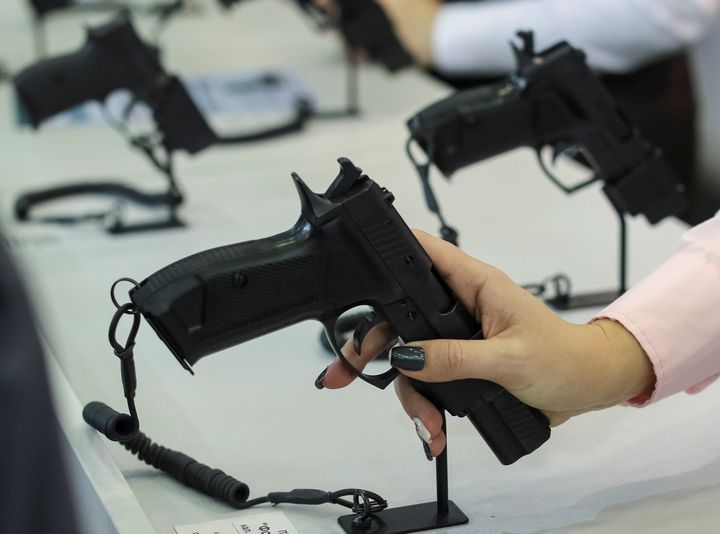Gun suicides declined significantly in two states after they passed laws allowing police to temporarily confiscate firearms from individuals determined to be a threat to themselves or others, according to new research.
A study published Friday in the journal Psychiatric Services examined years of death data following the passage of “red flag” laws in Connecticut, which became the first state to enact this sort of law in 1999, and Indiana, which followed suit in 2005.
In Indiana, the study found a 7.5 percent reduction in firearm suicides in the decade following the red flag law’s enactment. The link was less pronounced in Connecticut, at least initially. Gun suicides fell only 1.6 percent in the years after the law’s enactment, but enforcement of the law appeared to spike in 2007 following the mass shooting at Virginia Tech, leading to a 13.7 reduction in firearm suicides from 2007 to 2015.
One of the study’s authors says the research should give fuel to the state-led push for similar laws around the country, which advocates have held up as vital tools to prevent gun violence.
“Our data shows that when red flag laws are utilized, they have the effect of preventing large numbers of suicides,” Aaron Kivisto, an assistant professor of clinical psychology at the University of Indianapolis, told HuffPost.
To measure the effect of red flag laws, researchers created a model using data from other states as well as from Connecticut and Indiana in the years before they implemented their laws. After controlling for other factors known to affect suicide, including rates of gun ownership, unemployment and alcohol consumption, they were able to extrapolate what the suicide rate would have been in Connecticut and Indiana without the laws.
“Our estimates here were between 300 and 400 gun suicides prevented in the 10 years after Indiana enacted its law, and a little over 100 in Connecticut,” said Kivisto.

These declines translated to a decrease in overall suicides in Indiana. In Connecticut, however, the lower number of firearm suicides was offset by an increased number of suicides by other means.
Red flag laws have emerged as one of the most popular legislative responses to the February massacre at Marjory Stoneman Douglas High School in Parkland, Florida, in which 17 people were killed. The suspect in that shooting, a 19-year-old former student at the school, had attracted the attention of local police on numerous occasions before his attack, but officers had no authority to take his firearms.
Eight states now have red flag laws on the books, and Florida is among the four to have joined those ranks since the Parkland shooting. Other states are still considering legislation and appear poised to enact laws this session.
Most of these measures allow for law enforcement, family members or roommates to petition for a red flag, also known as a gun violence restraining order, against an individual whom they believe to be dangerous. This initiates a court process that can lead to the temporary confiscation of that person’s firearms and an order that they remain away from all guns for a period of time.
The standards of evidence and investigation required to authorize that seizure vary somewhat by state. All of the state measures include some level of judicial oversight and due process, but some critics of red flag laws say firearms should never be taken unless the owner is found guilty of a crime.
Although much of the current debate around red flag laws has revolved around their ability to disarm a potential mass murderer and give them time to cool off, Kivisto said that in states where these statutes have been in effect the longest, they’ve been used primarily on people who appear to pose a threat only to themselves.
“Red flag laws tend to be introduced in response to oftentimes a mass homicide, but in practice what we realized is they are not used very often to seize guns from people thought to be at risk of homicide,” Kivisto said.
Data out of Indiana showed that in some years about 80 percent of all gun seizures under red flag laws involved a perceived risk of suicide, added Kivisto. Any link between the laws and other forms of gun violence, such as homicide or intimate partner homicide, likely wouldn’t have been strong.
Trends in the use of red flag laws may reflect a lack of awareness among law enforcement or the public. Advocates for red flag laws in other states have expressed concerns that they’re not being sufficiently utilized, in part because there hasn’t been enough of a push to educate people on how and when to petition for someone’s firearms to be confiscated.
With red flag laws gaining broader acceptance across the country, often with bipartisan support from lawmakers and approval among both gun owners and non-gun owners, it’s possible that researchers will soon have enough data to begin measuring what effect they have on other types of shootings. Until then, Kivisto said, studies like his show that the measures are worth pursuing.
“Policymakers should take advantage of the data available,” said Kivisto. “There isn’t a lot yet, but what we do have tends to suggest that these can make a positive difference.”
If you or someone you know needs help, call 1-800-273-8255 for the National Suicide Prevention Lifeline. You can also text HOME to 741-741 for free, 24-hour support from the Crisis Text Line. Outside of the U.S., please visit the International Association for Suicide Prevention for a database of resources.
